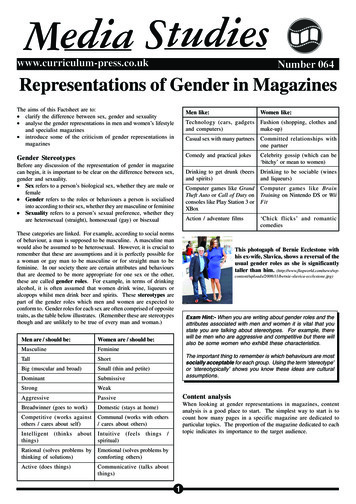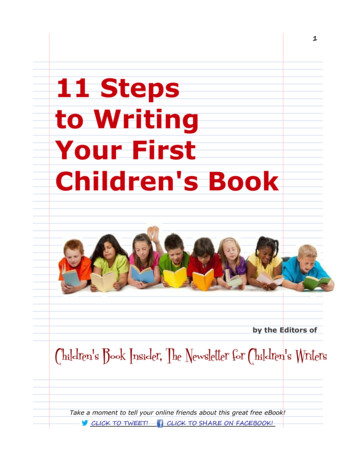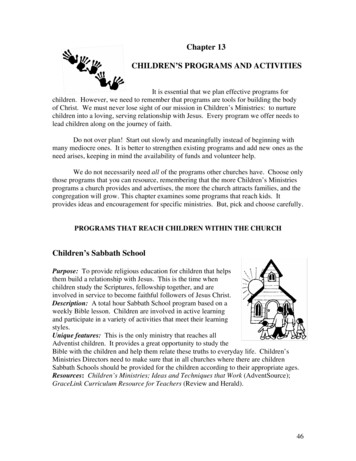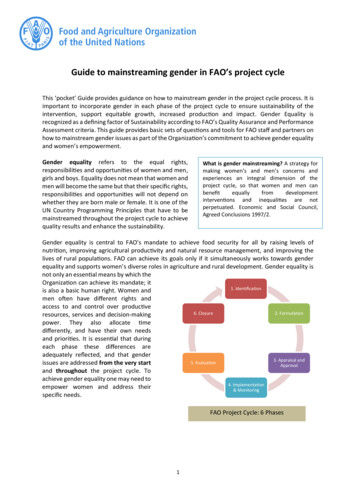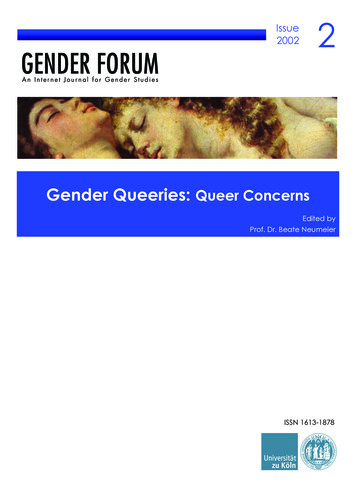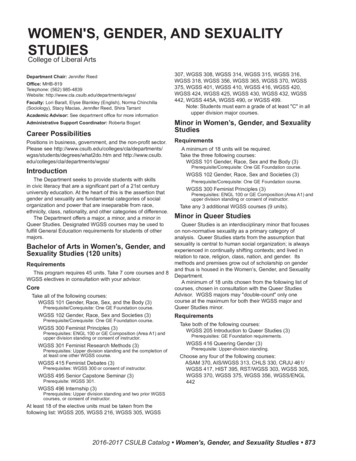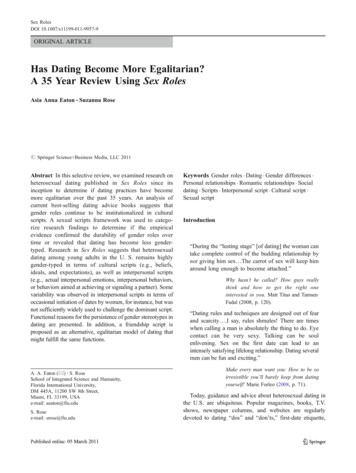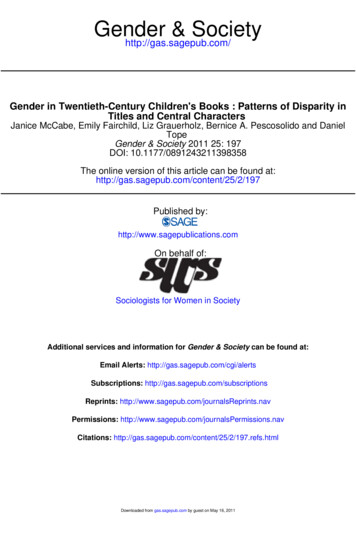
Transcription
Gender& Societyhttp://gas.sagepub.com/Gender in Twentieth-Century Children's Books : Patterns of Disparity inTitles and Central CharactersJanice McCabe, Emily Fairchild, Liz Grauerholz, Bernice A. Pescosolido and DanielTopeGender & Society 2011 25: 197DOI: 10.1177/0891243211398358The online version of this article can be found d by:http://www.sagepublications.comOn behalf of:Sociologists for Women in SocietyAdditional services and information for Gender & Society can be found at:Email Alerts: http://gas.sagepub.com/cgi/alertsSubscriptions: http://gas.sagepub.com/subscriptionsReprints: ions: tions: ownloaded from gas.sagepub.com by guest on May 16, 2011
GENDER IN TWENTIETHCENTURY CHILDREN’S BOOKSPatterns of Disparity in Titlesand Central CharactersJANICE MCCABEFlorida State UniversityEMILY FAIRCHILDNew College of FloridaLIZ GRAUERHOLZUniversity of Central FloridaBERNICE A. PESCOSOLIDOIndiana UniversityDANIEL TOPEFlorida State UniversityGender representations reproduce and legitimate gender systems. To examine this aspectof the gendered social order, we analyze the representation of males and females in thetitles and central characters of 5,618 children’s books published throughout the twentiethcentury in the United States. Compared to females, males are represented nearly twice asoften in titles and 1.6 times as often as central characters. By no measure in any bookseries (i.e., Caldecott award winners, Little Golden Books, and books listed in the Children’sCatalog) are females represented more frequently than males. We argue that these disparities are evidence of symbolic annihilation and have implications for children’s understandings of gender. Nevertheless, important differences in the extent of the disparity areevident by type of character (i.e., child or adult, human or animal), book series, and timeperiod. Specifically, representations of child central characters are the most equitable andanimals the most inequitable; Little Golden Books contain the most unequal representations; and the 1930s-1960s—the period between waves of feminist activism—exhibitsAUTHORS’ NOTE: An earlier version of this article was presented at the 2009 AnnualMeeting of the Southern Sociological Society. We thank Alex Capshew, Mary Hannah,Cher Jamison, Melissa Milkie, Abraham Peña, Teresa Roach, and Kayla Richburg for dataand research assistance with this project. We would also like to thank Annette Goldsmith,J. Sumerau, Editor Dana Britton, and the anonymous reviewers for their excellent advice.We acknowledge support from Indiana University College of Arts and Sciences to reprintbook images.GENDER & SOCIETY, Vol. 25 No. 2, April 2011 197-226DOI: 10.1177/0891243211398358 2011 by The Author(s)197Downloaded from gas.sagepub.com by guest on May 16, 2011
198 GENDER & SOCIETY / April 2011greater disparities than earlier and later periods. Examining multiple types of booksacross a long time period shows that change toward gender equality is uneven, nonlinear,and tied to patterns of feminist activism and backlash throughout the century.Keywords:adolescence/children; culture; media/mass communicationsResearch on gender representation in children’s literature has revealedpersistent patterns of gender inequality, despite some signs ofimprovement since Weitzman et al.’s (1972) classic study more than35 years ago. Recent studies continue to show a relative absence of womenand girls in titles and as central characters (e.g., Clark, Lennon, andMorris 1993; Hamilton et al. 2006), findings that mirror those from othersources of children’s media, including cartoons and coloring books (e.g.,Fitzpatrick and McPherson 2010; Klein and Shiffman 2009). Theoretically,this absence reflects a “symbolic annihilation” because it denies existenceto women and girls by ignoring or underrepresenting them in cultural products (Tuchman 1978). As such, children’s books reinforce, legitimate, andreproduce a patriarchal gender system.Because children’s literature provides valuable insights into popularculture, children’s worlds, stratification, and socialization, gender representation in children’s literature has been researched extensively. Yet moststudies provide snapshots of a small set of books during a particular timeperiod while making sweeping claims about change (or lack thereof) andgeneralizing to all other books. For instance, Weitzman et al. (1972, 1127)concentrated on a five-year period (1967-1971) but claimed that theirfindings were “applicable to the wide range of picture books.” Children’sliterature, however, has been shown to be highly sensitive to social forces,and the industry itself is far from monolithic in the types of books producedand messages conveyed (Pescosolido, Grauerholz, and Milkie 1997).While examining particular books during limited time periods may revealimportant insights about these periods and books, we know little aboutrepresentation of males and females in the broad range of books availableto children throughout the twentieth century.This study moves beyond ahistorical assumptions and methodologicallimitations that defined previous research by expanding coverage to 5,618books published throughout the twentieth century in the United States. Wefocus upon the most obvious markers of inequality—disparity in the representation of male and female characters in titles and central roles—inboth award-winning and non–award-winning books to explore how theseDownloaded from gas.sagepub.com by guest on May 16, 2011
McCabe et al. / GENDER IN CHILDREN’S BOOKS 199overt manifestations of bias vary across book types and over time. We alsoinvestigate how disparity in central characters varies by age (child oradult) and species (human or animal). We provide a historical examinationof symbolic annihilation by tying representation in books to patterns offeminist activism and backlash throughout the century. Differencesbetween the presence of males and females in books have implications forthe (unequal) ways gender is constructed. The disproportionate numbersof males in central roles may encourage children to accept the invisibilityof women and girls and to believe they are less important than men andboys, thereby reinforcing the gender system.Children’s Understandings of Gender: Schemas,Reader Response, and Symbolic AnnihilationNo medium has been more extensively studied than children’s literature.This is no doubt due, in part, to the cultural importance of children’s booksas a powerful means through which children learn their cultural heritage(Bettelheim 1977). Children’s books provide messages about right andwrong, the beautiful and the hideous, what is attainable and what is out ofbounds—in sum, a society’s ideals and directions. Simply put, children’sbooks are a celebration, reaffirmation, and dominant blueprint of sharedcultural values, meanings, and expectations.Childhood is central to the development of gender identity and schemas.By preschool, children have learned to categorize themselves and othersinto one of two gender identity categories, and parents, teachers, and peersbehave toward children based on these categories. The development of agender identity and understandings of the expectations associated with itcontinue throughout childhood. Along with parents, teachers, and peers,books contribute to how children understand what is expected of womenand men and shape how they think of their place in the social structure:Through stories, “children learn to constitute them selves [sic] as bipolarmales or females with the appropriate patterns of power and desire”(Davies 2003, 49). Books are one piece of a socialization and identityformation process that is colored by children’s prior understandings ofgender, or gender schemas. Because schemas are broad cognitive structures that organize and guide perception, they are often reinforced anddifficult to change. It takes consistent effort to combat dominant culturalmessages (Bem 1983), including those sent by the majority of books.The extensive body of research (often referred to as “reader response”)examining the role of the reader in constructing meanings of literatureDownloaded from gas.sagepub.com by guest on May 16, 2011
200 GENDER & SOCIETY / April 2011(e.g., Applebee 1978; Cullingford 1998) comes to a similar conclusion.We interpret stories through the filter of our prior knowledge about otherstories and everyday experiences; in other words, schemas shape ourinterpretations. Reading egalitarian books to children over a sustainedperiod of time shapes children’s gender attitudes and beliefs (e.g., Barclay1974; Trepanier-Street and Romatowski 1999). However, one book isunlikely to drastically change a child’s gender schema.The effects of gender schemas can be seen in children’s preferencesfor male characters. Boys and, to a lesser extent, girls prefer stories aboutboys and men (e.g., Bleakley, Westerberg, and Hopkins 1988; Connor andSerbin 1978). This research suggests that children see girls and women asless important and interesting. Even seeming exceptions to the pattern ofmale preference support the underlying premise: When boys identify witha girl as a central character, they redefine her as a secondary character(Segel 1986) and they identify male secondary characters as central characters when retelling stories (Davies 2003). Patterns of gender representation in children’s books, therefore, work with children’s existing schemasand beliefs about their own gender identity. A consistently unequal patternof males and females in children’s books thus contributes to and reinforceschildren’s gender schemas and identities.While representation in the media conveys social existence, exclusion(or underrepresentation) signifies nonexistence or “symbolic annihilation”(Tuchman 1978). Not showing a particular group or showing them lessfrequently than their proportion in the population conveys that the group isnot socially valued. This phenomenon has been documented in a range ofoutlets—from television (Tuchman 1978) to introductory sociology textbooks (Ferree and Hall 1990) to animated cartoons (Klein and Shiffman2009). Yet, research on “symbolic annihilation” has neglected children’sbooks and failed to tie representations to broader historical changes.Historical Change: Gender throughout the Twentieth CenturyInequitable gender representations may have diminished over time inthe United States, corresponding with women gaining rights throughoutthe century (e.g., voting and reproductive rights) and entrance into thepublic sphere via the workplace, politics, and media. However, it seemsmore likely that there will be periods of greater disparity and periods ofgreater parity, corresponding with upsurges in feminist activism and backlash against progressive gender reforms. For instance, Cancian and Ross(1981) identified a curvilinear pattern in newspapers and magazines’ coverage of women, finding that coverage peaked during the first wave ofDownloaded from gas.sagepub.com by guest on May 16, 2011
McCabe et al. / GENDER IN CHILDREN’S BOOKS 201feminist activism (1908-1920) and dipped until the second wave was wellunderway in 1970, when it began to rise again.Thus, we have reason to believe that representations during midcentury—after the 19th Amendment gave women the right to vote but before thesecond-wave women’s movement—may differ from other parts of thecentury. Historians have identified the 1930s as a time of backlash againstthe changes in gender expectations and sexual freedom of the 1920s (Cott1987; Scharf 1980). While resistance to these changes existed in the firsttwo decades of the century (Kimmel 1987), the tide shifted with the GreatDepression. Women were scorned for taking “male jobs” (Evans 1997;Scharf 1980), the increase in the number of women in the professions“came to a halt” (Scharf 1980, 85), and the media asked “Is FeminismDead?” in 1935 (Scharf 1980, 110). Even when women’s employmentskyrocketed during WWII, traditional notions of gender persisted throughthe valuation of the “domestic ideology” (Evans 1997; Friedan 1963;Rupp and Taylor 1987) and women were “criticized for failing to raisetheir sons properly” (Evans 1997, 234). This gender traditionalism andantifeminism persisted into the 1960s, although feminist challenges togender expectations began to swell again with President Kennedy’sCommission on the Status of Women, the Equal Pay Act, the publicationof The Feminine Mystique, and the founding of the National Organizationfor Women (Rupp and Taylor 1987). The cumulative effects of theseevents were apparent in the 1970s as feminism rapidly expanded in a second wave of activism (Cancian and Ross 1981; Evans 1997). Althoughthere was some resistance to feminism during the 1980s (Evans 1997;Faludi 1991), this latter part of the century saw a more consistent presenceof activism; by the mid-1990s, feminist solidarity was growing amongyounger women (Evans 1997) identified as feminism’s “third wave.”Based on these patterns of feminist activism and backlash, we expectrepresentation of women and girls to be closer to parity during activistperiods (1900-1929 and 1970-2000) and more absent during greater gendertraditionalism (1930-1969). We link the theoretical concept of symbolicannihilation to gender representation throughout the century.Gender Representation in Children’s LiteratureAs a whole, existing research on children’s books largely aligns withconcerns about symbolic annihilation by suggesting that the underlyingmessage conveyed to children is that women and girls occupy a less central role in society than do men or boys. Weitzman et al.’s (1972) groundbreaking study of children’s books showed that females were greatlyDownloaded from gas.sagepub.com by guest on May 16, 2011
202 GENDER & SOCIETY / April 2011underrepresented in titles and central roles. In 1967-1971, only one Caldecotthonoree—the major U.S. award given for children’s book illustrations—featured a female in the title while eight highlighted males. Since Weitzmanet al. (1972), most studies have similarly concluded that women and girlsare underrepresented (e.g., Clark, Lennon, and Morris 1993; Hamilton et al.2006; Kortenhaus and Demarest 1993; McDonald 2001; Tepper andCassidy 1999).1Evidence of the move toward parity, however, is equivocal. Some studies document improved visibility of women and girls over time (Oskamp,Kaufman, and Wolterbeek 1996; Williams et al. 1987). However, Clark,Lennon, and Morris (1993) found that the improvements noted in some ofthe early follow-up studies did not persist into the late 1980s. Other studies have documented more complex changes. For example, in research onCaldecott and other prize-winning books, Clark and colleagues foundmore female characters in the 1980s and 1990s than the 1970s and 2000s(Clark et al. 2007) and in the 1930s and 1950s than the 1940s and 1960s(Clark et al. 2003). Although not central to their argument, Weitzman et al.(1972) reported the ratio of males:females in titles as somewhat more balanced (8:3) across the entire period (since 1938) than for the five-yearperiod studied (8:1 in 1967-1971). Drawing on 2,216 books listed in theChildren’s Catalog 1900-1984, Grauerholz and Pescosolido (1989) foundthat both the early and later decades showed the most equality.Methodological issues in existing studies contribute to the lack ofconsistent conclusions. Most studies focus on relatively narrow time periods or only on books published since Weitzman et al.’s (1972) study (e.g.,Gooden and Gooden 2001; Oskamp, Kaufman, and Wolterbeek 1996;Teeper and Cassidy 1999). The tendency to focus only on Caldecott orother award-winning books also obscures our general understanding ofgender in children’s literature. While award-winning books represent animportant segment for a variety of reasons (e.g., they serve as models forother books, they are “gatekeepers” [Weitzman et al. 1972]), they are notnecessarily the most widely read books (Tepper and Cassidy 1999), norare they likely to be representative of children’s books. Yet, very fewstudies directly compare Caldecott winners to other books, and those thatdo produce mixed results (e.g., Hamilton et al. 2006; Kortenhaus andDemarest 1993; Tepper and Cassidy 1999). While not comprehensive,previous studies suggest that characters’ species and age produce variability in representation, with representations of animals being particularlyunequal and children more equal (Gooden and Gooden 2001; Hamiltonet al. 2006; Weitzman et al. 1972).Downloaded from gas.sagepub.com by guest on May 16, 2011
McCabe et al. / GENDER IN CHILDREN’S BOOKS 203In sum, despite a large body of research on representation of males andfemales in children’s books, serious gaps persist. Although some studiesmake direct comparisons to previous research, including Weitzman et al.’s(1972) “classic,” this approach renders intercoder reliability across studiesproblematic and makes temporal comparisons subject to error. Poorsampling techniques (including reliance upon convenience samples; e.g.,McDonald 2001); a focus on subtle types of discrimination that are difficult to quantify (e.g., emotional language or role behaviors; McDonald2001; Oskamp, Kaufman, and Wolterbeek1996; Tepper and Cassidy 1999);a lack of specificity regarding unit of analysis, reliability, and operationalization; and a lack of testing for statistical significance continue to plaguethis line of research. Here, we correct for these concerns to provide acomprehensive picture of inequality embedded in the literature producedfor children throughout the past century. Our historical examination of thesymbolic annihilation of women and girls in children’s books providesinsight into the social reproduction of gender inequality and the maintenanceof the gender system.METHODDataOur data include information on titles and central characters in 5,618books published throughout the twentieth century. We collected information from the full series of three sources: Caldecott award-winning books,1938-2000 (N 263); Little Golden Books, 1942-1993 (N 1,023); andthe Children’s Catalog, 1900-2000 (N 4,485). This data set provides arobust view of 101 years of U.S. children’s literature that attends to awardwinners, popular books, and the librarian’s standard reference.The Caldecott Medal is awarded annually by the Association forLibrary Service to Children (a division of the American Library Association)to the artist of the “most distinguished American Picture Book for Childrenpublished in the United States during the preceding year” (ALA.org 2011).The Association also recognizes Honor books (i.e., runners-up). We codedall 263 Medal and Honor books from 1938 (the inception of the award) to2000. These books represent an elite group whose influence on authors,the industry, teachers, and parents is widespread. Books bestowed theCaldecott award ensure high sales for publishers and shape industry standards (Weitzman et al. 1972).Downloaded from gas.sagepub.com by guest on May 16, 2011
204 GENDER & SOCIETY / April 2011The Little Golden Books are a widely popular and relatively inexpensive book series. More than 90 percent of Americans recognize theGolden Book brand (Marcus 2007). By 1986, the one billionth book in theseries had been published; that number reached two billion by 2002(Marcus 2007). Although some Caldecott medalists have illustrated LittleGolden Books, this series is markedly different from Caldecotts in printquality and cost; indeed, its success is due to the books’ affordability (e.g.,the average price in the 1940s was 25 cents; today it is 2.99) and marketingsavvy (e.g., they were sold not only in bookstores but grocery and department stores; Marcus 2007). We coded all 1,023 Little Golden Books published from 1942 (the inception of the series) to 1993. We coded thestandard Little Golden Books, which have golden binding on the book’scover, are 6¾ by 8 inches, and have 24 pages. We coded re-releases whenbooks were changed, including the story or length. We did not code other(rarely published) Golden books, such as Golden Story Books, Giant LittleGolden Books, and Tiny Books (Marcus 2007). After 1993, alterations inownership, production, and marketing strategies of Little Golden Books(see Marcus 2007) made systematic book selection impossible becausewe were unable to verify a list of the population of Little Golden Bookspublished after 1993.The Children’s Catalog, a compilation of book titles and summariesoriginally published in 1909 and now in its 19th edition, spans the twentieth century and is one of the most extensive listings of books available.It is designed for librarians and school media specialists to use in developing and maintaining collections (i.e., in making decisions about buying,rebinding, replacing, and discarding books), verifying bibliographic andaward information, identifying books appropriate for particular curricula,and assisting readers in locating books on specific topics (Price 2006). Forconsistency with other series used in this study, we coded all “easy books,”a designation used for the youngest readers, children from preschool tothird grade (Price 2006). The 153 Caldecott award winners listed in the“easy” section of the Catalog are included only once in our full set ofbooks; Little Golden Books do not appear in the Catalog. Each listing inthe Children’s Catalog provided the information needed for this study:title, date, and a brief description of the story. By design, descriptionsdetail “the book’s content” (Price 2006, xi). For example, the descriptionof Syd Hoff’s Barkley (1975), reads, in part:Barkley, an aging circus dog, has had a long career doing tricks—until oneday the four dogs on his back become a painful load. His owner retires himDownloaded from gas.sagepub.com by guest on May 16, 2011
McCabe et al. / GENDER IN CHILDREN’S BOOKS 205and Barkley walks away from the circus. But he is missed and reinstated,because he is needed to teach tricks to young dogs.This excerpt exemplifies how each description allowed us to obtain theinformation needed for our study (e.g., Barkley is the central character inthe book and is a male animal). To assess the validity of the title and central character information gathered from the Children’s Catalog, we randomly selected 50 books listed in the Catalog. We found 96.7 percentcoding agreement, supporting the utility of using the descriptions.Coding and VariablesMultiple coders participated in training sessions to use a standard form,developed by the team, to record information on all books receiving aCaldecott award since the award’s inception; all “easy books” listed in theChildren’s Catalog, published 1900-2000; and all Little Golden Bookspublished through 1993. Intercoder reliability was high. There was 97.5percent coding agreement for a subset (N 36) of Caldecott books and99.4 percent agreement for a subset (N 850) from the Children’s Catalog.These exceptionally high scores undoubtedly reflect our focus on only themost observable and blatant forms of disparity between males and females:presence as central characters and in the titles.We coded each title as containing a masculine name or pronoun, afeminine name or pronoun, both, neither, or nonidentifiable (e.g., DukeEllington: The Piano Prince and his Orchestra [1999] was coded “male”;Jinny: The Story of a Filly [1934] was coded “female”). In ambiguouscases, we used information (when present) from the story or descriptionto determine whether the title character was male or female (e.g., Barkley[1975]). Unless otherwise specified, the numbers of “male” and “female”titles include those coded as “both” (e.g., Mary and the Policeman [1929]was coded “male” and “female”).We determined central characters through the storyline or, in the case ofthe Children’s Catalog, descriptions of each book. We coded them as male,female, neither, or nonidentifiable and indicated whether they were human,animal, or other (e.g., inanimate object), and if human, whether they wereadults or children. We excluded “objects” from this analysis because ofthe small numbers that are male or female (i.e., 0.6 percent [N 25] of theChildren’s Catalog books have central characters who are male objects;0.4 percent [N 19] female objects). Thus, our main variables are: malesin title, females in title, male central characters (CC), female CC, maleDownloaded from gas.sagepub.com by guest on May 16, 2011
206 GENDER & SOCIETY / April 2011human CC, female human CC, male adult CC, female adult CC, malechild CC, female child CC, male animal CC, and female animal CC. Wealso coded publication dates.AnalysisTo provide an overview, we present descriptive statistics (means, modes,and ranges) and ratios of males to females for each variable (e.g., the ratioof boy compared to girl CC) for the full set of books and by book type,along with indicators of statistical significance. To examine historicaltrends, we use straight time series analysis.We determine statistical significance using Pearson’s chi-square test,Fisher’s exact test, and Wilcoxon sign test. Comparing the presence of malesand females in titles or as central characters violates the assumption of independence because some books have both males and females in the title or ascentral characters (thus, these two values [e.g., males in title and females intitle] are not mutually exclusive). Therefore, we use the Wilcoxon sign testwhen making these comparisons, which is appropriate for dependent samples.When comparing book series, we restrict our analysis to comparisons ofbooks that have only males or only females in titles or as central characters(i.e., we do not include books that have both a male and female in the samecategory, such as title, in these comparisons) and use Pearson’s chi-squaretest; where we compare numbers smaller than five (i.e., two Caldecott bookswith only female animal CC to 42 with only male animals), we use Fisher’sexact test. Because 153 books appeared in the “easy” section of the Children’sCatalog that also received a Caldecott award, the issue of independence limitsour ability to statistically compare these two series. As a result, we do notmake this specific comparison. Finally, because our data represent the population of books, and inferential statistics are inappropriate for comparing nonrandom samples to the larger body of children’s books, such comparisonsshould be made with caution. Nevertheless, we include them because webelieve that the group differences that these tests identify are valuable in furthering our understanding of gender disparities.We also use straight time series analysis (Ostrom 1990) to discoverwhether a particular historical era shows a substantial departure from gender parity in children’s books. To obtain the outcome variable for eachanalysis, we convert the ratio of males to females for each variable intoa proportion and calculate each proportion’s distance from 1. Hence, ourdependent variables gauge the distance from parity.For the time series analysis, our historical and theoretical emphasis ison an important midcentury era. To capture historical parity patterns, weDownloaded from gas.sagepub.com by guest on May 16, 2011
McCabe et al. / GENDER IN CHILDREN’S BOOKS 207create a dummy variable that spans 1930 to 1969. Years in this range arecoded 1 and 0 otherwise. We also include a linear-time-trend measure.The autocorrelation function (ACF) and partial autocorrelation function(PACF) suggest a first-order autoregressive process. The Breusch-GodfreyLM test did not suggest higher order autocorrelation (Enders 2004).Hence, we use a Cochrane-Orcutt time series regression model with semirobust standard errors. The Cochrane-Orcutt transformation corrects forfirst-order serial correlation across our data points. Because of our theoretical emphasis on parity shifts in particular eras, we did not includeadditional regressors aside from the linear-trend term. Nevertheless, weexamined model sensitivity by running both Newey-West and Hildreth-Lumodels (Gujarati and Porter 2009; Newey and West 1987). We also ran aseries of models using proportion female representation as the dependentvariable. All of these approaches yielded substantively similar results(details on request). Here, we present estimates from Cochrane-Orcutt timeseries regression.FINDINGSTwentieth-Century RepresentationsWe first provide, in Table 1, general yearly trends of the percentage ofbooks featuring males and females in titles, as well as among central characters. Here, the unit of analysis is year rather than book. With all book seriescombined, there are 101 cases (representing 5,618 books across 101 years).Because we are interested primarily in (dis)parity between representations of male and female characters, we focus on the presence of males orfemales. However, it is noteworthy that male or female characters are notpresent in many titles: 55 to 57 percent of Caldecott award winners andChildren’s Catalog; 43 percent in Little Golden Books. There were alsosome instances in which it was not possible to determine whether a character was male or female: 4 percent of Goldens, 8 percent of Caldecotts,and 19 percent of Catalogs had at least one such character.2The descriptive statistics in Table 1 point to three interesting patterns inrepresentations. First, there is a clear disparity across all measures: Malesare represented more frequently than females in titles and as central characters. For instance, on average, 36.5 percent of books each year includea male in the title compared to 17.5 percent that include a female. By nomeasure are females present more frequently than males. In fact, the modefor males in titles is 33, m
books published throughout the twentieth century in the United States. We focus upon the most obvious markers of inequality—disparity in the rep-resentation of male and female characters in titles and central roles—in both award-winning and non–award-winning books to explore how these


